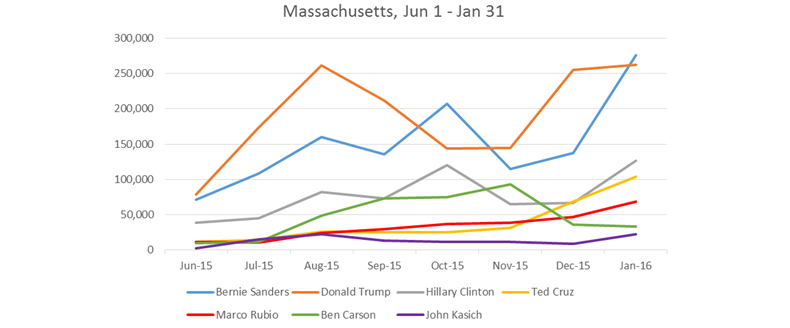Google searches don’t quite predict the outcome of elections (yet), but they CAN illuminate the underlying trends in a unique way. By showing us which candidates people wanted to know about and when, they give us a sense of momentum — positive or negative. Social media metrics can be skewed by a relatively small number of passionate supporters (as happened with Ron Paul in the past), but Google searches let us see what’s on the minds of people who may still be making those minds up.
For the Super Tuesday states, the folks at digital analytics firm iQuanti have done a great job of breaking out Google search volume for each presidential candidate since June. The results reinforce much of the generally accepted narrative (Bernie’s rise late last year, Ben Carson’s spike and fall), but they also contain a few things that may make you go “hmmmmm.” Of course, searches don’t necessarily indicate support, since people who hate a candidate may still search for information about him or her, but they’re a good proxy for interest.
Check out the full data on the iQuanti site, including numbers and trendlines for each candidate in each Super Tuesday, but here are some takeaways:
1. Trump Rules Google
In almost every state — and in most, for almost all of the period surveyed — Donald Trump leads everyone else, often by a factor of two or more. A fascinating pattern emerges in the data, though: Trump had an initial burst of early attention that faded in the fall. But, he spiked again late last year and has stayed solid and high ever since…for Trump, it’s been onward and upward.
2. Watch for Bernie in Colorado, Massachusetts and Minnesota
Searches for Sanders actually follow a trend similar to Trump’s, though with significantly lower volume in most states. He also saw a rise in attention late last year, but what’s really noteworthy is the state-by-state breakdown: he actually leads Trump in search volume in Massachusetts and is right behind him in Colorado, and he’s seen a BIG spike in attention in Minnesota (not surprisingly, he also leads in his home state of Vermont).
3. No One’s Searching for Kasich
Seriously, his trendline in every one of the states is low and consistent. He DID see a late bump in attention in January that looks good as a percentage, but his low baseline means that the actual numbers aren’t high. The Googleverse does not apparently have Kasich Fever.
4. Clinton is Solid and Steady
She’s saw a rise in interest in January, no doubt as we started having actual primary elections and caucuses. In most states that AREN’T highly conservative by nature, she’s been steady in third place behind Trump and Sanders.
5. Not Much Sign of Marcomentum, But Cruz Isn’t Spiking Either
Marco Rubio consistently ranks in the bottom half of the pack in just about every state. And while his numbers DO jump in the new year, his surge is still much lower as a percentage than Bernie’s or Hillary’s. A decent number of people have taken a look at Cruz in Oklahoma and Tennessee, but even in Texas Trump’s attracted far more searches.
Take all of this with a grain of salt, of course, but it’ll be interesting to compare the actual results with these data. Let’s see what happens tonight. Check out the full data set for yourself.
– cpd

